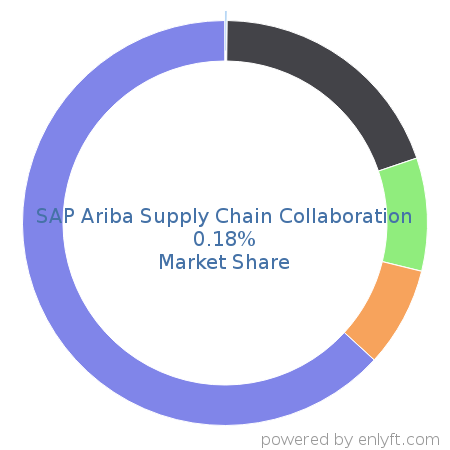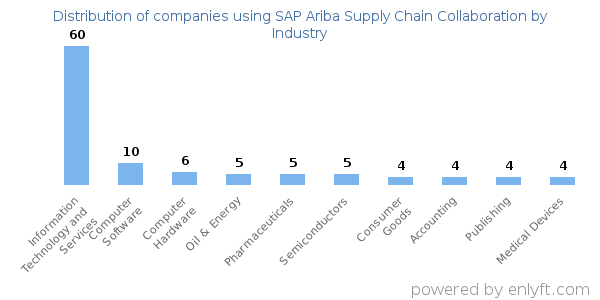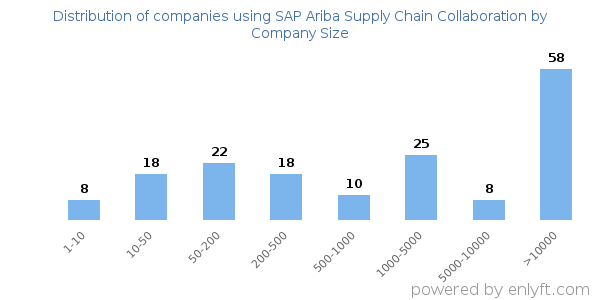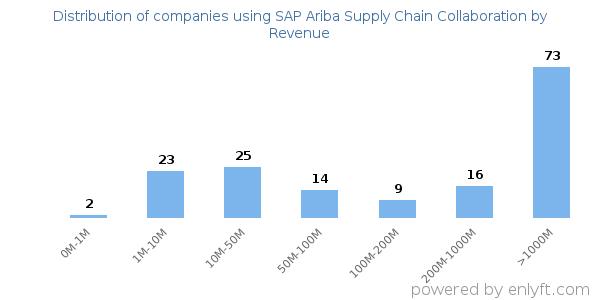Companies using SAP Ariba Supply Chain Collaboration
We have data on 175 companies that use SAP Ariba Supply Chain Collaboration. The companies using SAP Ariba Supply Chain Collaboration are most often found in United States and in the Information Technology and Services industry. SAP Ariba Supply Chain Collaboration is most often used by companies with >10000 employees and >1000M dollars in revenue. Our data for SAP Ariba Supply Chain Collaboration usage goes back as far as 6 years and 11 months.
If you’re interested in the companies that use SAP Ariba Supply Chain Collaboration, you may want to check out SAP Materials Management and JDA as well.
Who uses SAP Ariba Supply Chain Collaboration?
| Company | SAP SE |
| Website | sap.com |
| Country | United States |
| Revenue | >1000M |
| Company Size | >10000 |
| Company | Accenture PLC |
| Website | accenture.com |
| Country | Ireland |
| Revenue | >1000M |
| Company Size | >10000 |
| Company | Cognizant Technology Solutions Corp |
| Website | cognizant.com |
| Country | United States |
| Revenue | >1000M |
| Company Size | >10000 |
| Company | Infosys Ltd |
| Website | infosys.com |
| Country | India |
| Revenue | >1000M |
| Company Size | >10000 |
| Company | HP Development Company, L.P. |
| Website | hp.com |
| Country | United States |
| Revenue | >1000M |
| Company Size | >10000 |
| Company | Website | Country | Revenue | Company Size |
|---|---|---|---|---|
| SAP SE | sap.com | United States | >1000M | >10000 |
| Accenture PLC | accenture.com | Ireland | >1000M | >10000 |
| Cognizant Technology Solutions Corp | cognizant.com | United States | >1000M | >10000 |
| Infosys Ltd | infosys.com | India | >1000M | >10000 |
| HP Development Company, L.P. | hp.com | United States | >1000M | >10000 |
Target SAP Ariba Supply Chain Collaboration customers to accomplish your sales and marketing goals.
SAP Ariba Supply Chain Collaboration Market Share and Competitors in Supply Chain Management (SCM)
We use the best indexing techniques combined with advanced data science to monitor the market share of over 15,000 technology products, including Supply Chain Management (SCM). By scanning billions of public documents, we are able to collect deep insights on every company, with over 100 data fields per company at an average. In the Supply Chain Management (SCM) category, SAP Ariba Supply Chain Collaboration has a market share of about 0.2%. Other major and competing products in this category include:
Supply Chain Management (SCM)


What is SAP Ariba Supply Chain Collaboration?
SAP Ariba Supply Chain Collaboration solution helps you achieve an efficient supply chain by connecting all systems and stakeholders through Ariba Network.
Top Industries that use SAP Ariba Supply Chain Collaboration
Looking at SAP Ariba Supply Chain Collaboration customers by industry, we find that Information Technology and Services (33%) and Computer Software (6%) are the largest segments.

Top Countries that use SAP Ariba Supply Chain Collaboration
58% of SAP Ariba Supply Chain Collaboration customers are in United States and 6% are in India.

Distribution of companies that use SAP Ariba Supply Chain Collaboration based on company size (Employees)
Of all the customers that are using SAP Ariba Supply Chain Collaboration, a majority (52%) are large (>1000 employees), 16% are small (<50 employees) and 29% are medium-sized.

Distribution of companies that use SAP Ariba Supply Chain Collaboration based on company size (Revenue)
Of all the customers that are using SAP Ariba Supply Chain Collaboration, a majority (53%) are large (>$1000M), 28% are small (<$50M) and 13% are medium-sized.









